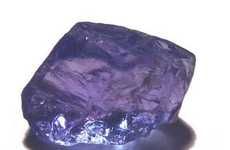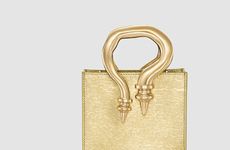
Demand Rises As Supply Dwindles
References: jewelrytelevision
The gorgeous bluish-purple gemstone tanzanite is becoming a rare commodity as a result of over-mining. The zoisite mineral was discovered in 1967 in the Meralani Hills near Arusha, Tanzania and is the only place in the world where the gemstone has been found.
Own some tanzanite already? Hold on to it. Jewelery and gem collectors around the world are growing desperate to get their hands on the precious stones before it is too late.
Authentic tanzanite alternates in colours depending on lighting, changing from sapphire blue to violet and sage-green. If your stone's changes are subtle, don't despair. To enhance colour, some stones are treated with artificial heat, resulting in diminished multicolour effects.
The gem gained popularity when Tiffany & Co. helped market the stone shortly after its discovery, quickly leading it to achieve high status. Sales boomed and it is still near the top of gemstone markets today. The largest tanzanite crystal found was in 2005, weighing in at 16,839 carats (7.5 lbs) and measuring 22 x 8 x 7 cm.
Adding to the rise in demand is the fact that Tanzanite resources are dwindling; it is estimated that there is only a 15 year supply left.
Better snatch one up for the family treasure trove while you can; it will be a priceless piece for future generations. Consider also that tanzanite is December's official birthstone—your granddaughter will want that special ring when her winter birthday rolls around you know.
Be wary of sketchy retailers, too. Common in tourist hot spots like Mexico, deceitful jewelers offer outrageous deals on gemstones. You might just be investing in near-worthless imitations like tanzanique or Cubic Zirconia, both of which closely mimic the real thing.
Keep your guard up—worse than finding out that you bought a knock-off is your woman finding out her engagement ring is fake; everyone knows a woman prefers the real thing!
For those who want to know more or are considering investing in this jewel, Jewelery Television is hosting a 24-hour tanzanite sales event on April 14. A company press release announced their acquisition of a large shipment of rough tanzanite from Arusha. They will be selling the tanzanite on the show, including cut stones and finished jewelry like earrings, bracelets, rings and pendants.
Own some tanzanite already? Hold on to it. Jewelery and gem collectors around the world are growing desperate to get their hands on the precious stones before it is too late.
Authentic tanzanite alternates in colours depending on lighting, changing from sapphire blue to violet and sage-green. If your stone's changes are subtle, don't despair. To enhance colour, some stones are treated with artificial heat, resulting in diminished multicolour effects.
The gem gained popularity when Tiffany & Co. helped market the stone shortly after its discovery, quickly leading it to achieve high status. Sales boomed and it is still near the top of gemstone markets today. The largest tanzanite crystal found was in 2005, weighing in at 16,839 carats (7.5 lbs) and measuring 22 x 8 x 7 cm.
Adding to the rise in demand is the fact that Tanzanite resources are dwindling; it is estimated that there is only a 15 year supply left.
Better snatch one up for the family treasure trove while you can; it will be a priceless piece for future generations. Consider also that tanzanite is December's official birthstone—your granddaughter will want that special ring when her winter birthday rolls around you know.
Be wary of sketchy retailers, too. Common in tourist hot spots like Mexico, deceitful jewelers offer outrageous deals on gemstones. You might just be investing in near-worthless imitations like tanzanique or Cubic Zirconia, both of which closely mimic the real thing.
Keep your guard up—worse than finding out that you bought a knock-off is your woman finding out her engagement ring is fake; everyone knows a woman prefers the real thing!
For those who want to know more or are considering investing in this jewel, Jewelery Television is hosting a 24-hour tanzanite sales event on April 14. A company press release announced their acquisition of a large shipment of rough tanzanite from Arusha. They will be selling the tanzanite on the show, including cut stones and finished jewelry like earrings, bracelets, rings and pendants.
Trend Themes
1. Rising Demand for Tanzanite - The dwindling supply of tanzanite gemstones is driving up demand, creating opportunities for businesses to capitalize on the rising popularity of this rare gem.
2. Ethical Sourcing and Sustainability in Gemstone Mining - The over-mining of tanzanite highlights the need for industry players to prioritize ethical sourcing and sustainable practices, leading to opportunities for innovative solutions in gemstone mining.
3. Emerging Alternatives to Tanzanite - As tanzanite resources continue to diminish, there is an opportunity for the development and promotion of alternative gemstones that can mimic tanzanite's unique color-changing properties.
Industry Implications
1. Jewelry Retail - Jewelry retailers can leverage the rising demand for tanzanite by offering exclusive designs, highlighting the gemstone's rarity, and ensuring ethical sourcing to attract conscious consumers.
2. Gemstone Mining - Innovative mining companies can explore sustainable practices, such as responsible extraction and reclamation, to meet the demand for tanzanite while minimizing environmental impact.
3. Gemstone Education and Certification - There is a growing need for gemstone experts, educational platforms, and certification services to inform consumers about the authenticity, quality, and ethical sourcing of tanzanite and other precious gemstones.
4.8
Score
Popularity
Activity
Freshness























